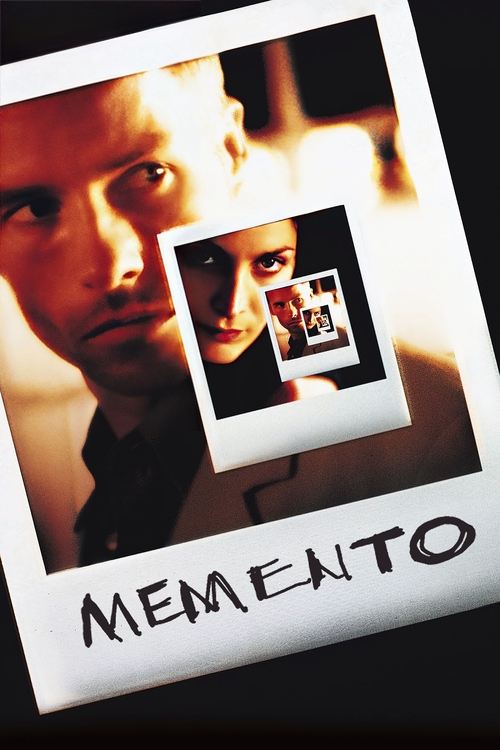Ask Your Own Question
What is the plot?
The story begins in a hauntingly disorienting way: a Polaroid photograph of a man's dead body slowly develops, but in reverse. The image fades backward, the bullet hole in his head closing up, the blood retracting, and the man rising from death to life, all in reverse motion. This man is John Edward Gammell, known as Teddy, and the film's opening scene sets the tone for a narrative that will unfold backward, challenging the viewer's grip on time and truth.
We then shift to black-and-white sequences that move forward in time, where Leonard Shelby sits alone in a grim motel room, speaking on the phone to an unknown caller. Leonard explains his tragic condition--anterograde amnesia--which means he cannot form new memories. He wakes each day with no recollection of what happened moments before. He recounts the attack on him and his wife, Catherine Shelby, which left her dead and him with this debilitating memory loss. Leonard's voice is steady but haunted as he says, "I have to believe in a world outside my own mind. I have to believe that my actions still have meaning, even if I can't remember them."
Leonard reveals that two men broke into their home. One attacker raped and strangled Catherine, while the other struck Leonard on the head with a blunt object, causing his amnesia. Leonard killed the first attacker in a desperate act of revenge, but the second man escaped. The police dismiss Leonard's claim that there was a second attacker, but Leonard is convinced the man's name is "John G" or "Jimmy G." To track his fragmented memories and keep his quest alive, Leonard tattoos key facts on his body and takes Polaroid photos of people and places, writing notes on them. His body becomes a living ledger of his investigation.
Leonard's story is intercut with color sequences moving backward in time, where he encounters Natalie, a bartender with her own troubled past. Natalie is wary but intrigued by Leonard's condition. She offers him shelter and information, but her motives are ambiguous. At one point, she warns Leonard about a dangerous man named Dodd, a drug dealer connected to the underworld Leonard is navigating. "You don't want to get involved with him," she says, her voice edged with fear and calculation.
Leonard's journey leads him to confront Dodd in a seedy motel room. The tension is palpable as Leonard, armed with his notes and tattoos, confronts Dodd. After a violent struggle, Leonard ties Dodd up in a closet. Leonard's confusion is evident as he questions his own memories: "Did you kill my wife? Are you John G?" Dodd denies involvement, but Leonard's fractured mind struggles to discern truth from deception.
Meanwhile, Leonard's relationship with Teddy deepens. Teddy presents himself as a helpful former police officer, guiding Leonard through the labyrinth of his investigation. Yet, Teddy's behavior is manipulative and contradictory. He claims to be protecting Leonard but also seems to exploit his condition. Teddy tells Leonard that the second attacker is Jimmy Grantz, a drug dealer. Leonard agrees to meet Jimmy, setting a trap based on Teddy's information.
In a grim parking lot, Leonard confronts Jimmy Grantz. Jimmy pleads for his life, revealing that he was involved in a drug deal with Teddy, not the attack on Catherine. Leonard strangles Jimmy in a desperate act, taking a Polaroid of his lifeless body and donning Jimmy's clothes. As the photo develops, the scene shifts from black-and-white to color, symbolizing the merging of past and present. Jimmy's whispered last word, "Sammy," confuses Leonard further, as he recalls Sammy Jankis, a man with a similar memory condition from his insurance investigator days.
The black-and-white sequences reveal Leonard's backstory as an insurance investigator who denied Sammy's claim, believing it was a psychological issue rather than real amnesia. Sammy's tragic story--his wife's accidental death from repeated insulin overdoses due to his memory loss--mirrors Leonard's own pain and raises doubts about his memories.
The climax unfolds in a stark abandoned building where Leonard confronts Teddy. The tension is electric as Teddy drops the mask of helpfulness and reveals the devastating truth: Leonard has already killed the real attacker, John G, long ago. Teddy confesses, "You killed him a year ago. I've been using you to kill people I want dead." Teddy explains that Leonard's mind resets constantly, and he is trapped in a cycle of violence, hunting new "John G's" to give his life meaning.
Teddy's revelation shatters Leonard's fragile reality. Teddy accuses Leonard of creating false memories to avoid facing his guilt, telling him that the story about Sammy Jankis is actually Leonard's own repressed memory. Leonard's face tightens with pain and confusion as he processes the betrayal and his own self-deception.
In a moment charged with tragic determination, Leonard chooses to manipulate his own future. He burns the Polaroids of Jimmy and the photograph of himself after killing the real John G, erasing evidence of the truth. Then, with cold resolve, Leonard takes a Polaroid of Teddy's face and writes on the back: "Don't believe his lies. He's the one. John G." He tattoos Teddy's license plate number on his body and drives off in Jimmy's car, setting himself up to kill Teddy in the future, ensuring his quest for revenge will continue indefinitely.
The film's final scene--chronologically the earliest--returns to the opening moment: Leonard shoots Teddy in the head in the abandoned building. Teddy's last words, a mix of anger and pity, echo: "You don't even know what you're doing." Leonard's expression is blank but resolute as he takes the Polaroid of Teddy's corpse, sealing the lie that will trap him forever.
Throughout the story, Leonard's world is fragmented by his memory loss, and the narrative's reverse chronology immerses the viewer in his disoriented experience. The deaths of Catherine Shelby, the first attacker, Dodd, Jimmy Grantz, and finally Teddy are all pivotal moments that propel Leonard's relentless, tragic pursuit of justice. Each confrontation is steeped in confusion, manipulation, and desperation, highlighting the fragile nature of truth when memory is unreliable.
In the end, Leonard's choice to deceive himself becomes his ultimate act of control and tragedy. He sacrifices the possibility of peace to preserve his purpose, ensuring that the cycle of violence and memory loss will never end. The film closes on Leonard driving away, a man condemned by his own mind to an endless hunt for a ghost named John G.
What is the ending?
We don't know.
Is there a post-credit scene?
The movie "Memento," directed by Christopher Nolan and released in 2000, does not have a post-credit scene. The film concludes with its final moments, leaving the audience to ponder the implications of memory, identity, and the nature of truth. The story wraps up with Leonard Shelby confronting the reality of his condition and the choices he has made, culminating in a powerful and thought-provoking ending that resonates long after the credits roll. The absence of a post-credit scene aligns with the film's themes, focusing on the complexity of Leonard's journey rather than providing additional content after the main narrative.
What condition does Leonard Shelby suffer from?
Leonard Shelby suffers from anterograde amnesia, a condition that prevents him from forming new memories after the traumatic event of his wife's murder. This condition forces him to rely on notes, photographs, and tattoos to keep track of information and people he encounters.
Who is Teddy and what role does he play in Leonard's quest?
Teddy, played by Joe Pantoliano, is a key character in Leonard's quest for revenge against his wife's killer. Initially appearing to help Leonard, he becomes a complex figure whose true intentions and relationship with Leonard are revealed as the story unfolds, leading to a climactic confrontation.
What significance do the tattoos have for Leonard?
The tattoos on Leonard's body serve as permanent reminders of important information he cannot remember due to his amnesia. Each tattoo represents a crucial piece of evidence or a person connected to his wife's murder, symbolizing his desperate attempt to maintain a sense of identity and purpose.
How does Leonard's relationship with Natalie evolve throughout the film?
Leonard's relationship with Natalie, played by Carrie-Anne Moss, is fraught with manipulation and ambiguity. Initially, she appears to be sympathetic and helpful, but as the story progresses, her true motives and connection to Leonard's past become increasingly complex, revealing her as both an ally and a potential adversary.
What is the significance of the Polaroid photographs in the story?
The Polaroid photographs are crucial tools for Leonard, allowing him to document people and events he cannot remember. Each photo includes notes that help him piece together his investigation into his wife's murder, serving as a visual representation of his fragmented memory and the struggle to create a coherent narrative of his life.
Is this family friendly?
We don't know. Memento is generally not considered family-friendly due to its themes, violence, and complex narrative structure. The film contains adult language, graphic violence, and discussions around traumatic experiences, which may be upsetting for children or sensitive viewers.
What is the plot twist?
Memento features a significant plot twist that reveals that Leonard, the protagonist suffering from short-term memory loss, has been manipulating his own narrative. Throughout the film, it is disclosed that Leonard has been led to believe he is seeking vengeance for his wife's murder, but by the end, it's revealed that he may have been responsible for her death himself, which he has suppressed from his memory. This twist reshapes the entire understanding of his quest and character, highlighting themes of memory, identity, and perception.
What is nataliex27s role and ending?
In the movie Memento, Natalie is portrayed by Carrie-Anne Moss. She plays a critical role in the story as she becomes involved with Leonard Shelby, the protagonist who suffers from anterograde amnesia and is trying to find his wife's killer. Throughout the film, Natalie's intentions are ambiguous; she helps Leonard but also manipulates him for her own purposes.
By the end of the film, it is revealed that Natalie has been using Leonard's condition to her advantage. After Leonard confronts her about her true nature, she is shown to have a deceitful side, and her role culminates in a betrayal. Ultimately, she is part of Leonard's ongoing struggle with his memories and the truth about who he can trust.
What people are Teddy having Leonard killing and why?
In "Memento," Teddy manipulates Leonard into killing people for his own purposes. Teddy takes advantage of Leonard's short-term memory loss to use him as a pawn in his own schemes. Specifically, he leads Leonard to believe that he is helping him find his wife's killer, but in reality, Teddy has been involved in some illegal activities and wants to eliminate threats to himself. Ultimately, Teddy's motivations are self-serving, and he is not as concerned with Leonard's quest for vengeance as he pretends to be.


